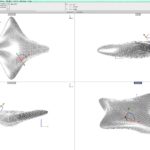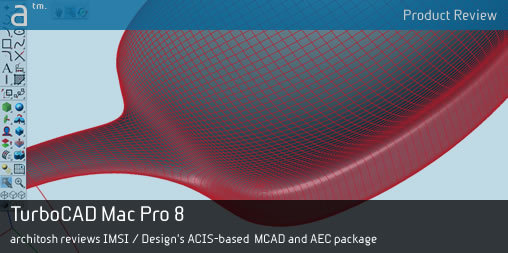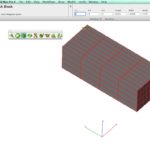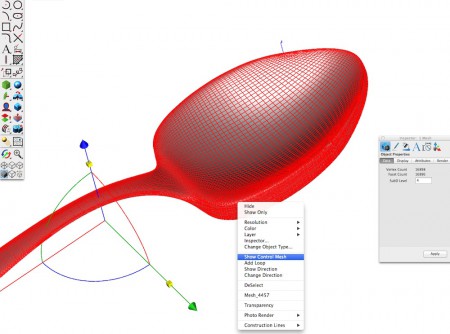It has been over a year and a half since we last reviewed IMSI/Design’s venerable TurboCAD Mac Pro, now at version 8. As noted in our last review, IMSI/Design’s overall family of TurboCAD CAD products competes primarily against Autodesk’s market share leading AutoCAD as “generalista supremo” of electronic drafting environments. And while the days of 2D CAD are far from over, like its many rivals, TurboCAD has long had solid 3D capabilities, these days powered by Spatial’s powerful ACIS geometry modeling kernel.
Any veteran Architosh reader knows that this site can talk the “kernel” talk like no other. Take a look at our extensive coverage of the new Vulkan graphics API and you will see that getting to the technology behind the technology matters to us. And it should to you as well if you are in the market for software in the CAD industry.
Key Modeling and ACIS Improvements
Since a major set of features in the latest TurboCAD Mac Pro involve the incorporation of the Spatial ACIS release 24, we can start our review there. For readers who are totally new to TurboCAD Mac products, our last review includes a bit of an introduction to how the program works. (for learning purposes…).
Back in 2013, TurboCAD Mac Pro was powered by Spatial ACIS R 22. Now in version 24 of the modeling kernel (aka: engine), TurboCAD Mac Pro gains many new advantages. The chief one among these is that TurboCAD Mac Pro 8 is now fully 64-bit. ACIS R24 itself introduced new 64-bit binaries for its Mac version and in the process deprecated the 32-bit version for the platform. Another big change related to overall performance of the latest TurboCAD Mac Pro 8 is that ACIS R24 delivers binaries for the Mac platform that are thread safe. This applies to multi-threaded operations—using more cores or processors on your Mac.
You may be curious to know what is meant by “thread safe” as it relates to ACIS R24 and its explanation bears value on this review. In a nutshell, the tricky business of using “multi-threading” in code development is making sure that individual threads do not compete for shared resources such as shared memory. When two threads write concurrently to the same shared memory resource problems can occur. Thread management is an important aspect of “multithreading” and the overall effectiveness of utilizing the latest CPU processors with many cores.
Core ACIS R24 Benefits
There are several new modeling features that come about because of ACIS R24 in version 8, but before we get to those we should summarize the core benefits as well.
- New fully 64-bit only (TurboCAD Mac Pro 8 requires 64-bit native OS X machines)
- Thread safe multi-threading
- Faster load, process and render of larger models and assemblies (directly relates to multi-threading notes above)
- 2.3 GB model limits have now been lifted to working with models of any size (only limited by on-board memory within your Mac system)
- Some boolean operations operate up to 60 percent faster (Spatia’s data)
- New and enhancements to Meshes
- Faster file saves, especially with larger models
On the second to last point about Meshes, TurboCAD Mac Pro version 8 now features new Quad mesh and Subdivision modeling tools. Let’s look at those next.
New Quad Mesh Tools
New in TurboCAD Mac Pro 8 are Quad Mesh modeling tools. Quad meshes, versus triangular meshes, offer other types of benefits, including the use of ring or loop selection tools in other 3D software programs. They are also useful for UV mapping.
In TurboCAD Mac Pro 8 a range of Quad mesh tools are available, including a mesh surface, mesh sphere, mesh block, mesh torus and, importantly, mesh skin. There are also mesh extrude, where you can extrude an arc, for example, and mesh lathe and mesh cover. The last tool on this palette is the subdivision tool. (see image 01 far tool on right)
With a mesh block, for example, the user creates the x, y and z dimensions of the basic block. A block mesh is made up of six quad mesh faces, each with its own grid blocks based on #X, #Y and #Z numeric input fields. Those fields can be edited before or after the mesh block is created.
The subdivision tool then enables the user to specify the level of mesh subdivisions, adding vertices and surfaces (quads), to surfaces to increase smoothness. Two choices for SubD’s include Faceted and Catmull-Clark method. Faceted smooths the mesh by subdividing the quads incrementally by three faces. Catmull-Clark is an algorithm that subdivides the existing faces and edges to smooth the quads.
When working with the new quad mesh tools and using subdivision, the user can control-click (left click) to bring up a context menu with numerous options, among them Show Subdivision. The result is a red colored subdivision surface grid showing the smaller faces generated by either of the two subdivision methods (Catmull-Clark or Faceted). (see image 04 below).
Importantly, while quad meshes enable complex smoothed shapes, they start essentially from one object type that is manipulated using the Gripper tools to pull discreet parts (faces) of the overall subdivision surface. From this process it is possible to create just about any smooth-bodied object, from a teaspoon to a concept for an atomic force space craft. (see next series of images – 05 – 06)

05 – Using a series of operations that edit individual mesh segments (scale, move, rotate) on a SubD model one can develop all kinds of forms.
In our final space ship model concepts you can see that surface formation is rather infinite in possibilities. In terms of degree of subdivisions possible, the limit we ran into is four (4) levels of smoothness. This is not a limitation of the Catmull-Clark algorithm, but perhaps a limit set by IMSI-Design itself within the framework of the ACIS R24 modeling engine.
next page: More Modeling and Woodworking Tools









Reader Comments
Architosh reviews the latest version of IMSI/Design’s TurboCAD Mac Pro 8. Since 2006 the company returned to the Mac…https://t.co/o9Rb8ljXK4
Architosh reviews the latest version of IMSI/Design’s TurboCAD Mac Pro 8. Since 2006 the company returned to the Mac…https://t.co/o9Rb8ljXK4
Architosh reviews the latest version of IMSI/Design’s TurboCAD Mac Pro 8. https://t.co/8htTlG9K7F @architosh
Architosh reviews the latest version of IMSI/Design’s TurboCAD Mac Pro 8. https://t.co/8htTlG9K7F @architosh
IMSI Design #TurboCAD Mac Pro 8 http://t.co/k1nQVbnUyI by Anthony Frausto-Robledo #cad #mcad
IMSI Design #TurboCAD Mac Pro 8 http://t.co/k1nQVbnUyI by Anthony Frausto-Robledo #cad #mcad
RT @architosh: Product Review: IMSI Design TurboCAD Mac Pro 8: It has been over a year and a half since we last reviewed … http://t.co/Q5…
RT @architosh: Product Review: IMSI Design TurboCAD Mac Pro 8: It has been over a year and a half since we last reviewed … http://t.co/Q5…
I think you mean that TurboCAD is Core Profile OpenGL based, not CoreGraphics.
@ cgbeige,
Actually, while TurboCAD is OpenGL based, I did in fact mean to refer to Apple Core Graphics (CoreGraphics), which is synonymous with Quartz (graphics layer). This app used to contain Carbon API code but is now fully Cocoa based. I suppose, and I’m guessing here, that IMSI/Design used Metrowerks’ PowerPlant IDE (integrated development environment) at one time. During app crashes if one looks at thread data on crashes you can often spot PowerPlant in the code lines. This was the old Carbon framework that saved Apple in the late 90’s and helped them jump from Classic to OS X (PowerPC only). Metrowerks PowerPlant for Mac vanished once Apple introduced OS X on Intel and Xcode, it’s own development tool.
The Carbon API is deprecated by Apple but is present, I’m fairly certain, even in Yosemite. I personally suspect some larger legacy apps with remaining Carbon code crash more frequently than they should now due to Carbon but I’m speculating. IMSI’s TurboCAD Mac Pro 8 ran solid the entire time (zero crashes) and it’s now fully Cocoa based.
I think you mean that TurboCAD is Core Profile OpenGL based, not CoreGraphics.
@ cgbeige,
Actually, while TurboCAD is OpenGL based, I did in fact mean to refer to Apple Core Graphics (CoreGraphics), which is synonymous with Quartz (graphics layer). This app used to contain Carbon API code but is now fully Cocoa based. I suppose, and I’m guessing here, that IMSI/Design used Metrowerks’ PowerPlant IDE (integrated development environment) at one time. During app crashes if one looks at thread data on crashes you can often spot PowerPlant in the code lines. This was the old Carbon framework that saved Apple in the late 90’s and helped them jump from Classic to OS X (PowerPC only). Metrowerks PowerPlant for Mac vanished once Apple introduced OS X on Intel and Xcode, it’s own development tool.
The Carbon API is deprecated by Apple but is present, I’m fairly certain, even in Yosemite. I personally suspect some larger legacy apps with remaining Carbon code crash more frequently than they should now due to Carbon but I’m speculating. IMSI’s TurboCAD Mac Pro 8 ran solid the entire time (zero crashes) and it’s now fully Cocoa based.
Archaeology and Modernity free downloads
Review’A work that will undoubtedly become a modern masterpiece… Archaeology and Modernity is one of the most powerful archaeology books I know. It promises
Comments are closed.